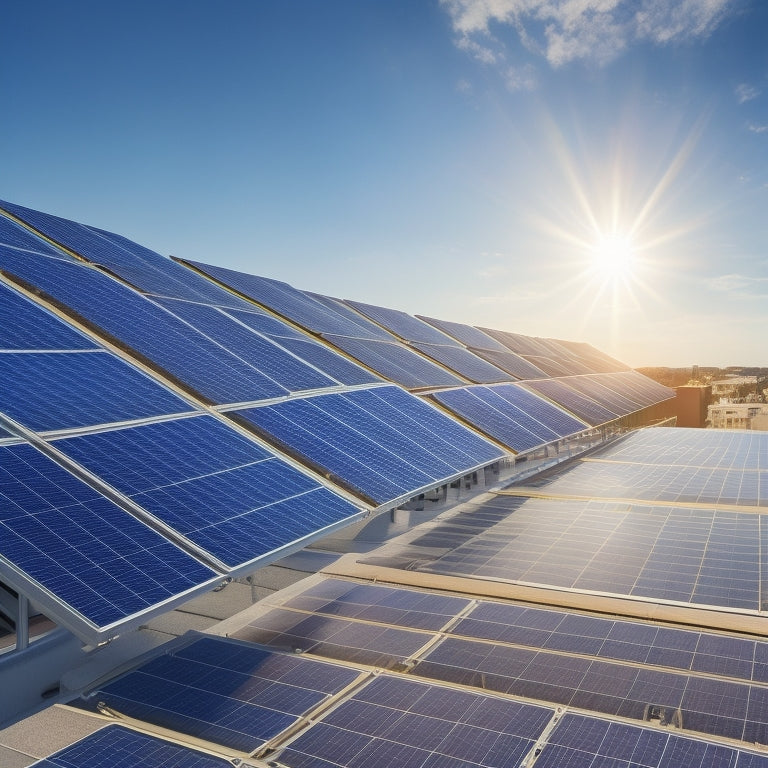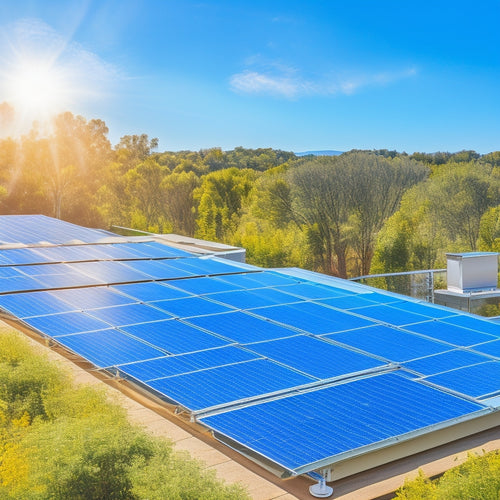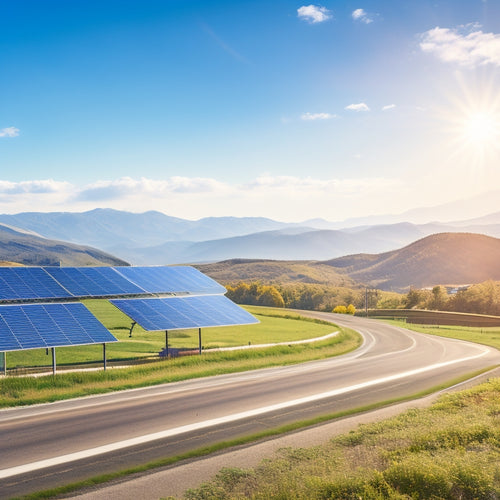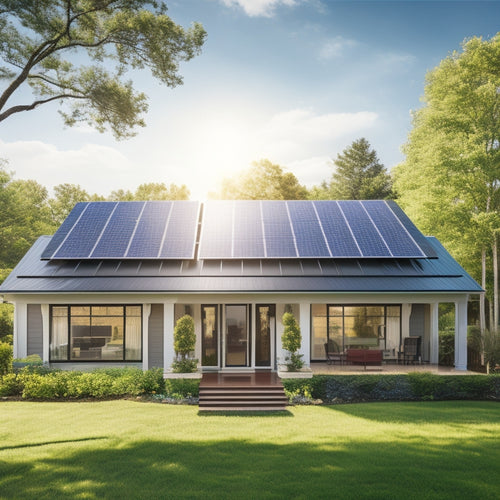
5 Best Solar Panel Angles for Efficiency
Share
You'll want to install your solar panels at an ideal angle to maximize energy harvesting, but the perfect angle depends on your location, roof pitch, and climate. For residential roofs, a steeper pitch is beneficial in heavy snowfall areas, while a flatter pitch suits regions with intense sunlight. For winter energy harvesting, steeper angles (40° to 50°) help capture more sunlight. Commercial use requires tilt angle adjustment based on location and shading, with optimal angles varying by latitude. By fine-tuning your solar panel angle, you can enhance energy production - and exploring the specifics of your situation will reveal the perfect angle for you.
Overview
- Steeper angles (40° to 50°) are ideal for winter energy harvesting, capturing more sunlight during the season's lower sun position.
- For commercial use, optimal tilt angles vary by latitude, ranging from 30° to 50°, with south-facing orientation being ideal for energy production.
- Adjustable mounts allow for seasonal angle adjustments, capturing up to 10% more energy by aligning with the sun's changing position.
- Tracking systems require precise daily angle adjustments, increasing energy production by up to 45% and ensuring maximum sunlight capture.
- In regions with heavy snowfall, steeper pitches (40° to 50°) are beneficial, while flatter pitches (25° to 35°) are more suitable for areas with intense sunlight.
Optimal Angle for Residential Roofs
When installing solar panels on residential roofs, the ideal angle is crucial to maximize energy harvesting. You need to take into account the roof pitch, as it affects the angle at which the panels are installed.
A steeper roof pitch allows for a more vertical installation, which can be beneficial in areas with heavy snowfall. However, a flatter roof pitch may be more suitable for areas with intense sunlight.
High-efficiency solar panels such as those from SunPower can also impact the best angle, as they're designed to perform well in various environmental conditions.
During installation, you should also take into account the surrounding environment, such as trees or buildings, that may cast shadows on the panels.
Maximizing Energy Harvest in Winter
As you refine your solar panel installation, it's equally important to take into account the seasonal variations that impact energy harvesting.
During winter, the sun is lower in the sky, resulting in lower winter sunlight intensity. To maximize energy harvest, consider using high-efficiency silicon solar cells high-efficiency conversions that can achieve conversion rates over 26%, making them suitable for off-grid systems.
Additionally, advanced bifacial solar panels can enhance energy output by up to 25% in high albedo environments. A steeper angle, typically between 40° to 50°, helps to capture more winter sunlight.
Additionally, consider the potential for snow accumulation on your panels. A slightly steeper angle can help snow slide off, reducing the impact on energy production.
Solar Panel Tilt for Commercial Use
Optimize your commercial solar panel installation by fine-tuning the tilt angle to maximize energy production. For commercial properties, the ideal tilt angle depends on the location's latitude and shading considerations. A steeper tilt angle can help reduce shading from surrounding buildings or trees.
| Latitude | Optimal Tilt Angle |
|---|---|
| 25° - 35° | 30° - 40° |
| 35° - 45° | 35° - 45° |
| 45° - 55° | 40° - 50° |
When determining your solar panel orientation, consider the direction of your roof or mounting system. A south-facing orientation is ideal, but east- or west-facing orientations can also be effective. By adjusting your solar panel tilt and orientation, you can guarantee your commercial installation operates at peak efficiency and generates maximum energy savings.
Angle Adjustments for Seasonal Changes
While your commercial solar panel installation is designed to operate at peak efficiency, seasonal changes can impact its performance.
To optimize your system's seasonal efficiency, you'll need to make angle adjustments to compensate for the sun's changing position. Adjustable solar panel roof mounts guarantee precise alignment, maximizing energy collection, and fine-tuning angles improves energy output, guaranteeing reliable renewable energy premium frames.
During winter, you'll want to tilt your panels at a steeper angle to capture more direct sunlight. In summer, a shallower angle is more effective.
By adjusting your panel angle, you can increase energy production by up to 10%. This process is known as angle optimization, and it's vital for maximizing your system's overall efficiency.
Ideal Angle for Tracking Systems
In commercial solar panel installations that employ tracking systems, the ideal angle for maximum energy harvesting is vital. You want to refine the angle to capture the most sunlight possible.
With tracking system benefits, you can increase energy production by up to 45%. To achieve this, angle optimization techniques are necessary. By adjusting the angle of your solar panels throughout the day, you can maximize energy output.
This is particularly important for commercial installations where energy production is essential. By using advanced tracking systems, you can make certain your solar panels are always at the best angle, resulting in maximum energy harvesting and increased freedom from energy dependence.
Frequently Asked Questions
Can Solar Panels Be Installed on a North-Facing Roof?
You can install solar panels on a north-facing roof, but you'll face installation challenges due to reduced energy output. However, north-facing benefits include lower temperatures, reducing heat-related losses, and potentially longer panel lifespan.
How Often Should I Clean My Solar Panels?
It's no coincidence that you're wondering how often to clean your solar panels - it's an essential aspect of solar panel maintenance. You should clean them every 6-12 months, depending on your location and climate, to guarantee peak energy harvesting and freedom from energy dependence.
Are There Any Solar Panel Angle Restrictions for Historic Buildings?
When installing solar panels on historic buildings, you'll need to comply with historic preservation regulations, which may restrict panel angles to maintain the building's original integrity, so research local solar regulations to guarantee your installation meets both energy and preservation goals.
Can I Install Solar Panels on a Metal Roof?
Just as a skilled builder constructs a strong foundation, you're wise to contemplate installing solar panels on your metal roof, leveraging its durability and ease of installation, while also assessing considerations like waterproofing and structural integrity.
Do Solar Panels Work Efficiently in Shaded Areas?
You'll find that solar panels don't work efficiently in shaded areas, as shaded performance greatly reduces solar efficiency. Even partial shading can decrease energy output, so it's crucial to assess your roof's shading conditions before installation.
Ready to Buy
By optimizing your solar panel angle, you can greatly enhance energy harvest. For instance, a study by the National Renewable Energy Laboratory found that adjusting the tilt of solar panels at the Denver Federal Center from 30° to 40° increased winter energy production by 12%. By understanding the ideal angle for your specific application, you can maximize your solar investment and reduce your carbon footprint. Precise angle adjustments can make a considerable difference in energy output, so it's essential to get it right.
Related Posts
-

What Types of Solar Energy Devices Are Available
You'll find several types of solar energy devices available today, each customized to different energy needs. Photovo...
-

Is Switching to Green Energy Solutions Easy
Switching to green energy solutions isn't just easy; it's also beneficial. You can greatly cut utility costs and enjo...
-

Home Solar Installation Cost
You're considering installing solar panels on your home, and the upfront cost is likely the biggest hurdle standing i...


